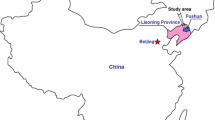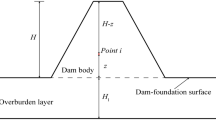Abstract
Ground subsidence disasters are characterized by wide distribution, long duration, and high-intensity damage, which can cause serious damages to surface buildings, underground pipelines, aquifers, and so on. Therefore, research on the stability evaluation of ground subsidence and subsidence deformation prediction is of great significance. This paper takes ground subsidence in Fushun City, Liaoning Province, China, as a case study. Combined with data from 60 monitoring points in the subsidence areas, the final settlement deformation values of all monitoring points were obtained through an arctangent function model using non-linear curve fitting with monitoring data. The proposed model could enable the prediction of settlement deformation trends of the monitoring points. Correlation coefficients are all above 0.937, indicating the strong reliability of the prediction model. By processing the final settlement deformation predictive values of the 60 monitoring points, a final settlement contour map was drawn with the help of the Kriging interpolation method. This map could forecast the whole distribution characteristics of ground settlement deformation in the research area. Then, risk zoning can be obtained by combining the settlement rate and residual settlement deformation in the study area. The research results could provide a basis for future city construction and regional planning in Fushun City.









Similar content being viewed by others
References
Bell FG, de Bruyn IA (1999) Subsidence problems due to abandoned pillar workings in coal seams. Bull Eng Geol Environ 57:225–237
David L, Marschalko M, Yilmaz I, Bedna´rˇova´ P, Niemiec D, Mikulenka V, Kubecˇka K (2015) Geodetic monitoring of roads as a tool for determination of hazard zones in areas influenced by deep coal mining. Bull Eng Geol Environ. doi:10.1007/s10064-015-0769-y
Díaz-Fernández ME, Álvarez-Fernández MI, Álvarez-Vigil AE (2010) Computation of influence functions for automatic mining subsidence prediction. Comput Geosci 14(1):83–103
Gonzalez-Nicieza C, Alvarez-Fernandez MI, Menendez-Diaz A, Alvarez-Vigil AE (2007) The influence of time on subsidence in the Central Asturian Coalfield. Bull Eng Geol Environ 66:319–329. doi:10.1007/s10064-007-0085-2
Huafeng Xu, Bin Liu, Zhigeng Fang (2014) New grey prediction model and its application in forecasting land subsidence in coal mine. Nat Hazards 71(2):1181–1194. doi:10.1007/s11069-013-0656-4
Nie Lei, Wang Hongfei, Xu Yan, Li Zechuang (2015) A new prediction model for mining subsidence deformation: the arc tangent function model. Nat Hazards 75(3):2185–2198. doi:10.1007/s11069-014-1421-z
Lei Nie, Min Zhang, Heqing Jian (2013) Analysis of surface subsidence mechanism and regularity under the influence of seism and fault. Nat Hazards 66:773–780
Levenberg K (1944) A method for the solution of certain non-linear problems in least squares. Q Appl Math 2(2):164–168
Lourakis MIA (2005) A brief description of the Levenberg–Marquardt algorithm implemented by levmar. Found Res Technol 4:1–6
Marquardt DW (1963) An algorithm for the least-squares estimation of nonlinear parameters. J Soc Ind Appl Math 11(2):431–441
Ruisheng Jia, Yanjun Peng, Hongmei Sun (2011) Mining subsidence prediction based on 3D stratigraphic model and visualization. Trans Edutainment VI 6758:206–215
Sheorey PR, Loui JP, Singh KB, Singh SK (2000) Ground subsidence observations and a modified influence function method for complete subsidence prediction. Int J Rock Mech Min Sci 37:801–818
Tong L, Leo L, Amatya B, Liu S (2015) Risk assessment and remediation strategies for highway construction in abandoned coal mine region: lessons learned from Xuzhou. Bull Eng Geol Environ, China. doi:10.1007/s10064-015-0760-7
Wanghua Sui, Yuan Hang, Ma Luxing Wu, Zhaoyang Zhou Yongjie, Guoqing Long, Lianbo Wei (2015) Interactions of overburden failure zones due to multiple-seam mining using longwall caving. Bull Eng Geol Environ 74(3):1019–1035
Ximin Cui, Jiachen Wang, Yisheng Liu (2001) Prediction of progressive surface subsidence above longwall coal mining using a time function. Int J Rock Mech Min Sci 38:1057–1063
Ximin Cui, Li Chunyi Hu, Qingfeng Miao Xiexing (2013) Prediction of surface subsidence due to underground mining based on the zenith angle. Int J Rock Mech Min Sci 60:246–252
Zhang B, Zhang L, Yang H, Zhang Z, Tao J (2015) Subsidence prediction and susceptibility zonation for collapse above goaf with thick alluvial cover: a case study of the Yongcheng coalfield Henan Province China. Bull Eng Geol Environ. doi:10.1007/s10064-015-0834-6
Zhanqiang Chang, Jinzhuang Wang, Mi Chen, Ao Zurui, Qi Yao (2015) A novel ground surface subsidence prediction model for sub-critical mining in the geological condition of a thick alluvium layer. Front Earth Sci 9(2):330–341
Acknowledgments
This project was financially supported by the National Natural Science Foundation of China (Grant No. 41172235). Special gratitude is also extended to those participants who have contributed to this work.
Author information
Authors and Affiliations
Corresponding author
Rights and permissions
About this article
Cite this article
Nie, L., Wang, H. & Xu, Y. Application of the arctangent function model in the prediction of ground mining subsidence deformation: a case study from Fushun City, Liaoning Province, China. Bull Eng Geol Environ 76, 1383–1398 (2017). https://doi.org/10.1007/s10064-016-0913-3
Received:
Accepted:
Published:
Issue Date:
DOI: https://doi.org/10.1007/s10064-016-0913-3




